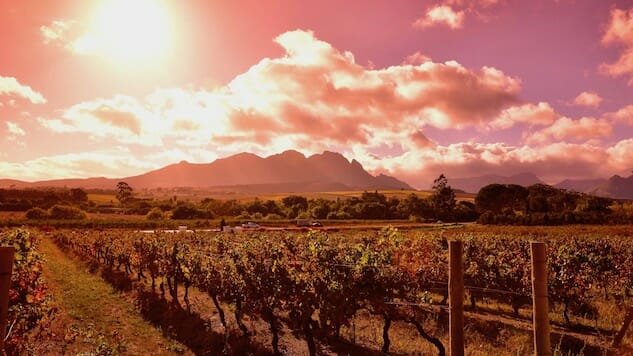52 Wines in 52 Weeks: Rediscovering the Suddenly Hip Chenin Blanc
Photo via South African Tourism/Flickr
My grandfather was a Cab man, generally speaking, but when he drank white wine, his go-to was always Chenin Blanc, a Loire Valley native that also goes by the aliases Vouvray, Agudelo, Pinau Gros, and Steen among others. And fittingly enough, it had fallen into fuddy-duddy grandpa-wine status until fairly recently. Now it has been officially “rediscovered” and is the darling of many a sommelier, so it is now officially a wine to know if you want to seem hip. Note: “Knowing” Chenin Blanc is a long-term deal.
Chenin Blanc is a good candidate for “desert island” white wine in the sense that it’s got completely amazing versatility, and can produce clean, dry, light wines, botrytized dessert wines and everything in between. It can be still, sparkling, or pétillant, which is “slightly fizzy.” Some Chenins are very cellar-worthy, others are “drink it now.” It’s tolerant of skin-contact maceration, which increases phenolic complexity, and of malolactic fermentation, which softens its naturally zippy acidity. Though it is a French native, it is planted widely across South America, New Zealand, the US west coast, and perhaps most notably, South Africa-it’s the signature grape of the Cape region.
Dry Chenin Blanc is often highly mineral in nature, and prominently (and pleasantly) acidic. Other commonly recognized notes are green plum, angelica and honey, and sometimes tropical fruit notes such as pineapple and even banana. Botrytized versions lead with honey and peach. In the middle range, depending where it came from and how it’s treated, you might find quince and pear, guava and, if oak barrel aging is involved, toast and vanilla traces (in some regions acacia barrels are favored; if used they will give the wine a much stronger yellow color).
The wide range of styles for this grape make it a fun food-pairing wine; there’s a Chenin for almost everything (I’m not sure it stands up especially well to red meat but you might even disagree on that). Sweeter styles are in the “serve me with the spicy stuff” range; drier ones can be friends to creamy sauces, pates and other rich foods where the crisp acidity is a welcome foil.
Nine Bottles to Try

Kiona Ice Wine (Red Mountain, WA $22)
Disclosure: This is on the walk of shame list of “wines Amy has literally had for breakfast.” Nothing that isn’t special makes that list-when you’re on a wine tasting tour you can easily start your day early enough that the most dedicated wineheads will tend to spit stuff out because It’s Just Too Much. I’m saying, this stuff is special. Kiona is not a small operation; they farm a very large slice of the Red Mountain region and both make a lot of their own wine and sell a lot of grapes to a host of other winemakers. They make more than one style of Chenin but I’m singling this out because ice wines are just weird and nifty. I believe it is the most expensive Chenin Blanc from Red Mountain, which reflects the level of babysitting required to make a good one. Ice wines are the latest of late harvest wines, picked while frozen on the vine and processed while still frozen to maximize a concentrated extraction. The results can be quirky or cloying if there isn’t enough acid to give it structure but this is not an example of that, it’s brilliant. Golden, honeyed, with hints of pineapple (I also get pineapple guava) and a trace of dried apricot. Try it for breakfast?
Aromatherapy (Clarksburg, CA $15)
If you are not familiar with Chenin Blanc this one’s a super-approachable, entry-level iteration that says “quaffable” very loudly. I paired it with puttering in the garden on the first hot day of the season and was very contented with the situation. Fruity and quite dry, this wine isn’t the most complicated or nuanced Chenin in the world but it’s a generous one with strong notes of pear, apple, nectarine and a hint of something tropical (the label will tell you to expect passionfruit’ what I tasted was a little more like pineapple but hey). I had it a la carte, but I expect it’s pretty food-friendly. It’s friendly, just in general.
Badenhorst “Secateurs” Chenin Blanc (South Africa, $15)
-

-

-

-

-

-

-

-

-

-

-

-

-

-

-

-

-

-

-

-

-

-

-

-

-

-

-

-

-

-

-

-

-

-

-

-

-

-

-

-








































